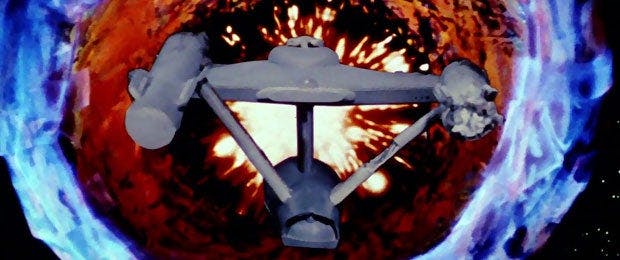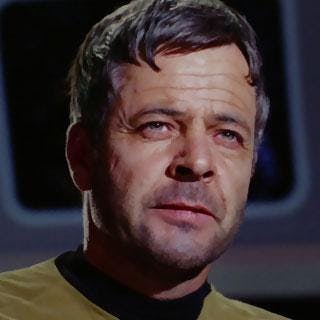Published Mar 4, 2012
"Doomsday" & More With Norman Spinrad, Part 1
"Doomsday" & More With Norman Spinrad, Part 1

Norman Spinrad penned “The Doomsday Machine,” one of the original Star Trek’s most memorable episodes, and he also penned “He Walked Among Us,” a script that went unproduced – at Spinrad’s own urging – and then seemingly vanished for 45 years. That teleplay recently made its way back to Spinrad – long a respected, award-winning author -- when a fan asked him to autograph it at a convention. Such recent developments prompted StarTrek.com to reach out to Spinrad, who granted us a detailed, no-nonsense interview about his experiences with Gene Roddenberry and Gene Coon on “The Doomsday Machine” and “He Walked Among Us.” He also talked about his current projects. Part one is down below and visit StarTrek.com again tomorrow for part two.
Let’s go back to 1967. How did you first hook up with Gene Roddenberry and Star Trek?
Spinrad: I had been working at a literary agency and we were handling the Clarke-Kubrick/2001 project. When I moved to L.A., I was a film critic and I wrote a couple of pieces about what I knew about that, and then I wrote a review of it. I wrote a big feature piece in the Cinema magazine, which was an important critical magazine at the time. I had my problems with 2001. At the same time, Gene Roddenberry was showing his first (Star Trek) pilot at science fiction events. I thought it was very good and I made some kind of mention in my Cinema magazine piece, unfavorably comparing 2001 to Gene Roddenberry’s first Star Trek pilot, the one that didn’t sell. I praised that. So, Gene called me up to thank me and to give me the usual pro forma thing: “Well, perhaps you’d like to come in and talk about writing a Star Trek.” I was re-writing Bug Jack Barron at that time, which was my breakthrough. It was typical L.A. politics, but in this it was true… I said to Gene, “I can’t talk about that now, Gene. I’m a month or so from finishing my work on this novel. Call me back in six weeks.” Having been an agent, I knew that strategy, but I was being sincere. I couldn’t have done it then. So he did call me back in six weeks. I went in and he said, “Look, we’re running out of money. Can you think of something that we can shoot on standing sets, so we don’t have to build anything?” I had an early novelette, which wasn’t very good, which was something like the story of “Doomsday Machine” and something like Moby Dick. So I told him the story and that was it. He liked it and they shot it.
You were on set the whole shoot. That almost never happens, even now…
Spinrad: That was very rare. They usually don’t allow writers on the set. I was 27 years old at the time. It was the first thing I had done. I’d done what he’d asked me to do, in terms of writing the episode to budget, and so I guess he trusted me to be there.

What did you make of the machine they devised?
Spinrad: That was the only thing that was disappointing about it. The original idea, which was complicated, is maybe a machine, but it’s maybe an artificial organism, to serve the same purpose. Then you have the question, “When does an artificial organism become a machine and when does a machine become an artificial organism?" The thing I had in my head was not like the thing that they shot. Gene said to me after I finished the script, “Look, can you draw the thing for us, please?” I’m not much of an artist. I paint a little bit now, but I still can’t do it very well. So I really worked on it. I drew the thing. It had complicated tentacle things that had the laser or whatever on the tips. So the thing looked ambiguous; you wondered looking at it, “Is this alive or is it a robot?” Then, when they shot it, they showed me what they’d do it with. I said to Gene, “After I went through all the work on this, this is what you shoot? It looks like a wind sock dipped in cement.” Gene, having been a pilot, said to me, “That’s what it is, it’s a wind sock dipped in cement. We didn’t have any money for anything else.”
For what it’s worth, StarTrek.com readers have referred to the machine as a giant doobie, a giant joint, a giant piece of %&@*, a giant cannoli, a massive lit cigar and a flying eggroll.
Spinrad: I think I called it a giant turnip, but as soon as I saw it I did call it a wind sock dipped in cement.
Going back to you being on set, did Shatner or Nimoy ever say anything to you about this script you’d penned for them?
Spinrad: Sure, but the funniest thing is there’s a sequence in there, dialogue, that goes Spock, Kirk, Spock, Kirk. While I’m on the set I see that William Shatner, in between takes, is sitting somewhere. He’s got the script and penciling out Spock lines, because he had something in contract saying that he had to have the most lines, that Nimoy couldn’t have more lines than he did. So, Marc Daniels, who was the director, starts to shoot this. Five blown takes. I’m there. It’s really an usual honor. You’re not really supposed to stick your nose into this. But I can’t stand it finally. I know what’s wrong. There’s a reaction line from Spock that’s missing. It just can’t work (without it). So I call Marc Daniels over into the corner. I said, “Listen, Marc, the reason you’re having trouble with this is because of the missing Spock line that Shatner took out. I know the whole reason why that is. We can’t put it back in, but maybe you just tell Leonard to grunt. Can you get away with a grunt?” And that’s the way they shot it.

Now, if we’ve got our history right, the story was that they originally wanted Robert Ryan for the role of Decker. William Windom got the part, but Ryan might have been very interesting, too. Is it true; did they want Ryan?
Spinrad: Yes, that’s what Gene said to me. He said, “We want something to shoot on the ship set, and we want something for Robert Ryan.” I didn’t really like Robert Ryan. Some of the dialogue got changed a little bit because it was William Windom and not Robert Ryan. They were different kinds of personae. With Ryan, it was going to push more towards Ahab, a stronger, angrier kind of persona. So, yeah, it was supposed to for Robert Ryan.
If there’s any major criticism of your script, it’s that it resembled Fred Saberhagen’s Berserker series…
Spinrad: You know, I’ve heard that. As shot, it resembled the Berserker series more than what I originally wrote, because what I originally wrote was an organism. It was ambiguous. If it resembled anything, and quite deliberately, it wasn’t Saberhagen’s stuff – I mean, the machine thing was a little bit like that – but what it really was, was Moby Dick. The story, even at the end, if you remember the end of Moby Dick, Ahab goes down with the whale. Well, there it is. The thing is, with Moby Dick, Ahab hasn’t lost his ship to the whale. He’s lost his leg to the whale. So, it’s not guilt; it’s straightforward hate. Well, it’s not exactly a straightforward novel, but that’s the basic notion. So I wasn’t conscious of the Saberhagen stuff when I was doing this, but I certainly was conscious of Moby Dick. And, actually, my unpublished novelette, which was the other genesis of (“The Doomsday Machine”) was written before the Saberhagen stuff.
What did you ultimately think of the episode and did you see the remastered version, with the upgraded FX?
Spinrad: I liked the (original) episode, except for the wind sock. Then, when they were doing the upgraded version, it was obviously much better quality. I talked to the people doing that and they asked me, “Do you want us to do the thing itself the way you had it or should we do it the way they shot it?” I said, “Do it the way I had it,” but they did it the way they shot it. They upgraded it, but they didn’t do that change.
Be sure to visit StarTrek.com again tomorrow for the second half of our exclusive interview.

